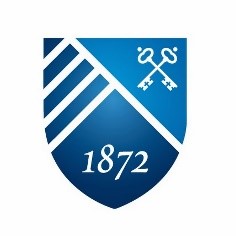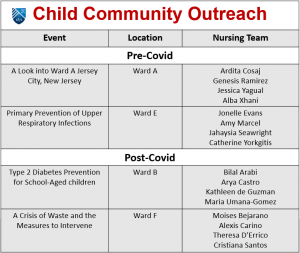Improving Health Outcomes for Jersey City Children
 Saint Peter’s University is small enough to know your name and big enough to bring the world to your door. Inspired by its Jesuit, Catholic legacy, commitment to individual attention and grounding in the liberal arts. Saint Peter’s University educates a diverse community of learners in undergraduate, graduate and professional programs. Students of this historic educational institution are expected to excel intellectually, lead ethically, serve compassionately and promote justice in an ever-changing urban and global environment.
Saint Peter’s University is small enough to know your name and big enough to bring the world to your door. Inspired by its Jesuit, Catholic legacy, commitment to individual attention and grounding in the liberal arts. Saint Peter’s University educates a diverse community of learners in undergraduate, graduate and professional programs. Students of this historic educational institution are expected to excel intellectually, lead ethically, serve compassionately and promote justice in an ever-changing urban and global environment.
Saint Peter’s University is a proud Jersey City anchor institution and values its long-standing partnership and tradition of community service. In keeping with this tradition, a group of senior students from the School of Nursing embarked on an initiative that focused on improving the health outcomes of children in several underserved wards of the city.
HealthierJC + Saint Peter’s University
The proposed Saint Peter’s University program was a collaboration between the School of Nursing, the Campus Caulfield School of Education, and Ministry outreach. The program was designed to first identify a prevalent public health concern impacting vulnerable youth populations, and then designing experiential education sessions to remediate these community health concerns.
This program closely aligned with the HealthierJC mission to expand access to quality education, promote fellowship, and build future community leaders. In awarding the mini-grant, HealthierJC acknowledged the ongoing contribution of Saint Peter’s University in advancing a Culture of Health throughout all Jersey City neighborhoods.

Experiential Health Education
A total of sixteen senior nursing students from Saint Peter’s University participated in this community health outreach program. They divided into 4 (four) teams, and each team was assigned a Jersey City ward to assess the baseline childhood health environment. Each nursing team conducted a survey of their assigned ward, and compiled data from various sources to determine the relative strengths and challenges of the ward from a child health and wellness perspective.
Based on a qualitative and quantitative assessment, the nursing students next identified key factors negatively impacting the health and well-being of the child population within each ward. An intervention and experiential teaching approach tailored to the specific needs of each ward was then developed to mitigate child health risk factors.
Pre-covid, the nursing teams for Ward A and Ward E were able to conduct their educational sessions in person at the Main Branch Library. In Ward A, 5th – 7th graders participated in “A Look into Ward A” session, and 5 to 10-year-olds from Ward E learned about “Primary Prevention of Upper Respiratory Infections”.
Post covid, two virtual experiential learning presentations were conducted for Jersey City students in Ward B and Ward F. The entire 5th grade of Learning Community Charter School in Ward B participated in “Type 2 Diabetes Prevention for Children”. The 2nd grade class of Whitney M. Young, Jr. Elementary School in Ward F, virtually attended the “Crisis of Waste and Measures to Intervene”.
 To better understand the experiential learning education facilitated by the Saint Peter’s University nursing students, a profile of Ward A: “A Look into Ward A” is provided below.
To better understand the experiential learning education facilitated by the Saint Peter’s University nursing students, a profile of Ward A: “A Look into Ward A” is provided below.
Based on a Ward A health risk assessment, the nursing students prioritized the need to decrease the rate of smoking among young people. The facilitation was designed to intervene and modify the behavior of children in grades 5 – 7, at an age where many start to experiment with cigarette smoking and vaping.
To demonstrate the detrimental health effects of smoking on the body, the facilitation utilized a medical school simulation chest mannequin. This allowed students to listen through a stethoscope, and also hear with their naked ear, the various congested and damaged lung sounds that result from smoking. Next, the impact of restricted blood flow and airflow due to smoking was simulated by using a small cocktail straw and a large beverage straw. By drinking water through both straws, the children were able to understand the difference between open and constricted blood vessels. And by breathing through both straws, they experienced the difference between open and obstructed airflow to the lungs.
The children responded positively to this hands-on interactive learning experience about the dangerous health implications of smoking. The session left an indelible impression that they understood, and could articulate to others. Even adult library employees who observed the session commented that the experiential learning format was very informative, and made a compelling case to stop smoking. The nursing students also benefited from the Child Community Outreach program. They gained experience understanding issues affecting health parity in urban communities, and taking action to overcome health challenges by directly sharing valuable health intervention strategies with members of the community.
Moving Forward…
 Given the success of the Child Community Outreach Program, Saint Peter’s University took steps to develop other community experiential learning programs. Moving forward, the School of Nursing has committed to ensuring that all nursing students:
Given the success of the Child Community Outreach Program, Saint Peter’s University took steps to develop other community experiential learning programs. Moving forward, the School of Nursing has committed to ensuring that all nursing students:
- Experience grass roots community engagement in Jersey City.
- Gain an appreciation for using experiential education to relay valuable health information to all age groups.
- Seek opportunities to collaborate with HealthierJC to advance innovative health initiatives.
For more information on Saint Peter’s University, please visit the organization’s website at https://www.saintpeters.edu/
